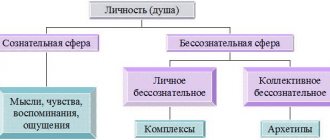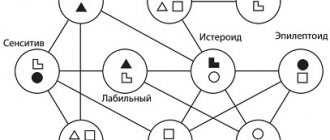Carl Gustav Jung became the second, after Adler, student of Sigmund Freud. Freud was reluctant to take on students, but from 1909 to 1913 both scientists were faithful comrades, associates, and like-minded people. Then the disagreements began. Jung refuted Freud's postulate that the human psyche is based on libido. He began his own research, based on the history of human development, the foundations of cultural studies, anthropology, religion and even mysticism.
This is how the analytical psychology of K.G. Jung, the essence of which is based on the concepts of the collective and individual unconscious, as well as personality archetypes.
Analytical psychology K.G. Jung - Fundamentals, Description
The problem of meaning... is the last analytical concept that crowns the general doctrine of the psyche, just as the concept of personality crowns the entire system of psychology.
Alexey Nikolaevich Leontyev
- 1.Basic provisions
- 2.Archetypes
- 3.Collective unconscious
- 4.Individual unconscious
- 5. Analytical psychology is primarily therapy
- 6. Contribution to modern psychotherapy
- Very simple about the subconscious
- Dementia - what is this disease?
- Schizoid and Schizoid: Signs and Causes
- Paraphrenic syndrome in schizophrenia. Clinical picture
- Psychologist - what kind of specialist is this? Let's find out more
Basic provisions
Jung introduced new concepts into terminology that define the profound influence on the formation and formation of a person’s personality.
In a psychiatric clinic, under his supervision there were several dozen people with various mental disorders. Working with patients, Jung came to the conclusion that the integrity of the human psyche is not determined only by his consciousness.
There are systems that form the structure of personality under the influence of external and internal factors. These systems formed the basis of his teaching.
Jung's analytical psychology: differences from psychoanalysis
Jung, a representative of the classical school of psychoanalysis, viewed the subconscious differently than Freud. In his opinion, personality is a set of attitudes of consciousness, innate and realized archetypes. Freud believed that the unconscious accumulates ignored base manifestations of personality. Jung believed that a person can accumulate both low and high. The filling of the unconscious depends on the individual.
Jung called individualization the driving force behind personality development—the achievement of integrity, the merging of the structure of the main parts of the psyche.
Archetypes
K.G. Jung on archetypes Under the influence of the collective unconscious, a person develops a general model of perception of the world, which is laid down in childhood. Jung defines the following types of archetypes:
- The ego
is the center of self-awareness through the interconnection of the collective and individual unconscious. If the connection is broken, then the human psyche begins to collapse. - A persona
is a “mask” in which a person appears in society. Each individual can have an infinite number of personas. They include demeanor, communication style, character, and presentation of oneself in society. - Anima and Animus
are the feminine and masculine principles. The less Anima in a man, the more rude and primitive he is. The more animus in a woman, the less inclined she is to pity, patience, and compassion. Jung believed that in old age both principles are balanced and a person enters a phase of harmony. In this way he gains wisdom. - Shadow
– hidden subconscious fears. They were formed in childhood. Then they transformed into complexes. Throughout his life, a person suppresses his secret desires, dreams, and fears. If you find harmony with the Shadow, then the feeling of shame for your childhood fears will go away and the person will be able to find a common language with society. - Self
– the main archetype that organizes and protects personal integrity. Thanks to him, the individual finds compromises and ways to eliminate contradictions. A person can independently direct his own negative traits into a positive direction. For example, aggressiveness can develop into a desire to achieve goals (in business, sports, art and other areas of activity).If the self does not cope with the assigned tasks, internal conflicts arise. They can lead to mental disorders. Then psychotherapy comes to the rescue.
Classical school: principles, main features of analytical psychology
According to Jung, the main process that guides a person is the desire for individualization. It consists of self-realization, selection of the necessary psychological material and removal of unnecessary material. Self-realization consists of two key stages. The first occurs during adolescence, when a person separates from the general postulates in order to find individuality. He is filled with negativity towards others, primarily towards his own parents.
Having gone through the process of personality development, the individual strives from personal values to social ones:
- desire to share;
- spirituality;
- love of work;
- feeling-oriented;
- attention to others.
A mature personality is characterized by a commitment to the idea of creation. In Jung's view, the main principle of development is merging with the collective unconscious. If a person stops developing, he experiences neurotic symptoms: depression, fetishism, various phobias.
Collective unconscious
Personality is formed under the influence of the experience of previous generations of humanity.
Ethnic groups, nationalities, nations and races did not appear out of nowhere. They were created on the basis of general concepts about life, the formation of common mental images, which later became the basis for religious beliefs, culture, and philosophy. The collective unconscious influences the formation of rules of behavior, mentality, and actions adopted for society as a whole. Thus, it determines the fate of the individual in society. The connection can be traced at an intuitive level and is therefore difficult to explain.
This unconscious has not an individual, but a general nature of content and behavior. It contains historical, ethnic, sociocultural, and family foundations.
The essence of analytical psychology: place in the system of sciences
Analytical psychology is a psychodynamic direction created by Jung on the basis of Freud's psychoanalysis. Its essence lies in the collection and analysis of the deep motivation of the individual, based on the content of the unconscious sphere of the individual. Jung's teachings are based on the idea of the collective unconscious - a collection of cultural, religious and historical images.
The problem with psychoanalysis that critics of this approach point out is subjectivity. The interpretation of analysis materials depends on the personality of the psychoanalyst, and does not have clear criteria, unlike other methods of psychotherapy.
Individual unconscious
An individual personality type is formed on the basis of personal experience.
Experience is gained by receiving information from the outside (extroversion) or by immersing oneself and one’s own rethinking of the events that have occurred (introversion). During his research, Jung divided the information a person receives into two systems:
- Ectopsychic
- connected with the external world and includes sensations, thinking, feelings and intuition; - Endopsychic
- associated with the inner world and includes memory, emotions and affects.
Through knowledge of the unconscious, a person goes through the process of self-realization.
A person becomes an independent unit. This is interesting
: It is believed that under the influence of the dominant function a certain psychological type is formed - an extrovert or an introvert, and also the main types of characters are formed (choleric, melancholic, sanguine, phlegmatic).
Classic concepts of analytical psychology: the theory of the unconscious
For analytical theory, the unconscious is a key component of the human personality, combined with consciousness. All suppressed emotions and feelings, rejected by consciousness, go into the unconscious. But as they continue to exist, images of thoughts and feelings break into consciousness in the form of dreams.
Through the personal unconscious, a person is connected with the collective unconscious. It contains archetypes that are common to all people. In the process of processing incoming information by the consciousness, a person often encounters images that do not evoke any associations in him. There is no corresponding experience in his life experience. The contents of the collective unconscious include answers to deep questions about life, love, happiness and others.
To correctly interpret the theory of the unconscious, you need to take into account the meaning of archetypes. They are the same for people, regardless of culture and nationality, just as their physiological processes are the same. Archetypes cannot be studied using traditional methods; their understanding largely depends on the imagination of the psychotherapist.
Analytical psychology is primarily therapy
Jung was a practicing psychotherapist, so all his discoveries were created by him on theoretical conclusions and practical application.
Jung devoted his entire life to creating a method of working with the unconscious. He believed that positive results can only be achieved with complete trust between the patient and the doctor. Therefore, he practiced conversations, encouraged any kind of creativity, helped the patient build new, more comfortable relationships with others, projecting them onto the doctor.
To understand the unconscious, Jung used the following methods:
- Association test
. In the process, stimulus words are identified that cause painful heightened feelings. You can find out what worries a person at the subconscious level by re-reading the associative series and putting the words together. - Dream analysis
. Jung paid special attention to this method. He considered dreams to be a manifestation of the position of a self-regulating mental system. This unconscious warns a person about imbalance. To interpret dreams, Jung used the amplification method (searching for parallels with well-known motifs in art, culture, literature, religion). - Active imagination
. Jung considered creativity to be one of the most effective therapies.
For reference:
According to the psychotherapist, working with directions should harmonize the relationship between the conscious and unconscious in a person.
Analytical psychology of Carl Gustav Jung
Carl Gustav Jung was born in Kesswil, Switzerland in 1875. Grew up in Basel, Switzerland. The only son of a Swiss Reformed pastor, he was a deeply introverted child but an excellent student. He read voraciously, especially philosophical and religious literature, and enjoyed solitary walks during which he marveled at the mysteries of nature. During his school years, Jung recalled, he was completely absorbed in dreams, supernatural visions and fantasies (Jung, 1961). He was convinced that he had secret knowledge about the future; He also had a fantasy that two different people coexisted within him. Jung studied medicine at the University of Basel and received his medical degree in psychiatry in 1900. In the same year, he took the position of assistant at the Zurich Hospital for the Mentally Ill, where he worked under the direction of Eugene Bleuler, the author of the term “schizophrenia.” Jung's interest in the complex mental life of schizophrenic patients soon led him to the works of Freud (Jung, 1906/1960). After reading The Interpretation of Dreams, Jung began to correspond regularly with Freud. They finally met at Freud's house in Vienna in 1907. This visit by Jung to Freud marked the beginning of a close personal and professional relationship. Jung's education made a deep impression on Freud. He believed that Jung could ideally represent psychoanalysis in the world scientific community, since he was not Jewish. Jung was accepted as the "eldest son" with the title of "heir apparent and crown prince". He was elected the first president of the International Psychoanalytic Association in 1910. However, in 1913, the two scientists broke off their relationship in a classic Oedipal scenario (Alexander, 1982). The following year, Jung resigned as president of the Psychoanalytic Association and left it. The rupture was accelerated by reasons of both a personal nature and theoretical differences. They never met again.
Over the next four years, Jung experienced a severe mental crisis, and this weakened him so much that he refused to give a course of lectures at the University of Zurich. He was literally obsessed with studying his own dreams and fantasies, which, according to some scientists, almost led him to insanity (Stern, 1976). It was only towards the end of the First World War that he was able to interrupt his journey through the labyrinths of the inner world to create a new approach to the study of personality, where human aspirations and spiritual needs acted as the main ideas. Jung attributed all his later work and creative activity to the influence of this period of painful introspection of the abysses of his unconscious. His autobiography, Memories, Dreams, Reflections, begins with the statement: “My life is the story of the self-manifestation of the unconscious” (Jung, 1961, p. 3).
A tragic episode in Jung's life is associated with accusations of Nazi sympathies. Jung passionately rejected these attacks and was eventually rehabilitated. He devoted his later life to traveling around the world and lecturing. Studying different cultures in America, Africa and Asia gave him the opportunity to expand his understanding of human nature. Analytical psychology eventually found a very wide audience in different countries, and many of his books have not lost their relevance today.
Jung died in 1961 at the age of 86 in Kusnacht, Switzerland.
Basic concepts and principles of analytical psychology:
As a result of Jung's processing of psychoanalysis, a whole complex of complex ideas appeared from such diverse fields of knowledge as psychology, philosophy, astrology, archeology, mythology, theology and literature. This breadth of intellectual exploration, coupled with Jung's complex and enigmatic writing style, is why his psychological theory is one of the most difficult to understand. Recognizing these complexities, we nevertheless hope that a brief introduction to Jung's views will serve as a starting point for further reading of his writings.
Personality structure
Jung argued that the soul (a term analogous to personality in Jung's theory) is composed of three separate but interacting structures: the ego, the personal unconscious, and the collective unconscious (Jung, 1931/1969).
The ego is the center of the sphere of consciousness. It is a component of the psyche, which includes all those thoughts, feelings, memories and sensations through which we feel our integrity, constancy and perceive ourselves as people. The ego serves as the basis of our self-awareness, and thanks to it we are able to see the results of our ordinary conscious activities.
The personal unconscious contains conflicts and memories that were once conscious but are now repressed or forgotten. It also includes those sensory impressions that are not bright enough to be noted in consciousness. Thus, Jung's concept of the personal unconscious is somewhat similar to Freud's. However, Jung went further than Freud, emphasizing that the personal unconscious contains complexes, or accumulations of emotionally charged thoughts, feelings and memories, brought by the individual from his past personal experience or from ancestral, hereditary experience (Jung, 1921/1973). According to Jung's ideas, these complexes, arranged around the most common themes, can have a fairly strong influence on the behavior of an individual. For example, a person with a power complex may expend a significant amount of mental energy on activities directly or symbolically related to the theme of power. The same may be true of a person who is strongly influenced by his mother, father, or under the power of money, sex, or some other kind of complex. Once formed, the complex begins to influence a person’s behavior and attitude. Jung argued that the material of each of us’s personal unconscious is unique and, as a rule, accessible to awareness. As a result, components of the complex, or even the entire complex, may become conscious and have an unduly strong influence on the individual's life.
Finally, Jung suggested the existence of a deeper layer in the structure of personality, which he called the collective unconscious (Jung, 1936/1969). The collective unconscious is a repository of latent memory traces of humanity and even of our anthropoid ancestors. It reflects thoughts and feelings common to all human beings and resulting from our common emotional past. As Jung himself said, “the collective unconscious contains the entire spiritual heritage of human evolution, reborn in the structure of the brain of each individual” (Campbell, 1971). Thus, the content of the collective unconscious is formed due to heredity and is the same for all humanity. It is important to note that the concept of the collective unconscious was the main reason for the differences between Jung and Freud.
Archetypes.
Jung hypothesized that the collective unconscious consists of powerful primary mental images, so-called archetypes (literally, “primary patterns”)* (Jung, 1968). Archetypes are innate ideas or memories that predispose people to perceive, experience, and respond to events in a certain way. In reality, these are not memories or images as such, but rather predisposing factors under the influence of which people exhibit universal patterns of perception, thinking and action in response to some object or event. What is innate here is the tendency to respond emotionally, cognitively, and behaviorally to specific situations—for example, an unexpected encounter with a parent, a loved one, a stranger, a snake, or death.
* Archetype (Greek ????????? from “????” - “beginning” and “?????” - “image”) - in late antique philosophy (Philo of Alexandria and others) a prototype , idea. (Editor's note)
Among the many archetypes described by Jung are the mother, the child, the hero, the sage, the sun deity, the rogue, God and death.
Examples of archetypes described by Jung
| Archetype | Definition | Symbols |
| Anima | The unconscious feminine side of a man's personality | Woman, Virgin Mary, Mona Lisa |
| Animus | The unconscious masculine side of a woman's personality | Man, Jesus Christ, Don Juan |
| A person | The social role of the individual stemming from social expectations and early learning | Mask |
| Shadow | The unconscious opposite of what the individual persistently asserts in consciousness | Satan, Hitler, Hussein |
| Self | The embodiment of integrity and harmony, the regulating center of personality | Mandala |
| Sage | Personification of life wisdom and maturity | Prophet |
| God | The ultimate realization of psychic reality projected onto the external world | Sun's eye |
Jung believed that each archetype is associated with a tendency to express a certain type of feeling and thought in relation to a corresponding object or situation.
For example, a child's perception of his mother contains aspects of her actual characteristics that are colored by unconscious ideas about such archetypal maternal attributes as nurturing, fertility, and dependency. Further, Jung suggested that archetypal images and ideas are often reflected in dreams and are also often found in culture in the form of symbols used in painting, literature and religion. In particular, he emphasized that symbols characteristic of different cultures often show striking similarities because they go back to archetypes common to all humanity. For example, in many cultures he encountered images of mandala, which are symbolic embodiments of the unity and integrity of the Self. Jung believed that understanding archetypal symbols helps him in analyzing the patient’s dreams. Some of the most important archetypes
The number of archetypes in the collective unconscious can be unlimited. However, special attention in Jung's theoretical system is paid to the mask, anime and animus, shadow and self.
A mask or persona (from the Latin word “persona,” meaning theatrical mask, guise) is our public face, that is, how we show ourselves in relationships with other people. The mask represents the many roles that we play in accordance with social requirements. In Jung's understanding, a mask serves the purpose of impressing others or hiding one's true self from others. The mask as an archetype is necessary for us to get along with other people in everyday life. However, Jung warned that if this archetype becomes too important, a person can become shallow, superficial, reduced to a role, and alienated from true emotional experience.
In contrast to the role played by the mask in our adaptation to the world around us, the shadow archetype represents the repressed dark, bad and animal side of the personality. The shadow contains our socially unacceptable sexual and aggressive impulses, immoral thoughts and passions. But the shadow also has positive properties. Jung viewed the shadow as the source of vitality, spontaneity and creativity in an individual's life. According to Jung, the function of the ego is to channel the energy of the shadow, to curb the harmful side of our nature to such an extent that we can live in harmony with others, but at the same time openly express our impulses and enjoy a healthy and creative life .
The archetypes of anima and animus express Jung's recognition of the innate androgynous nature of people. The anima represents the inner image of a woman in a man, his unconscious feminine side, while the animus is the inner image of a man in a woman, her unconscious masculine side. These archetypes are based, at least in part, on the biological fact that men and women produce both male and female hormones. This archetype, Jung believed, had evolved over many centuries in the collective unconscious as a result of experiences with the opposite sex. Many men have been "feminized" at least to some extent by years of marriage to women, but the opposite is true for women. Jung insisted that anima and animus, like all other archetypes, must be expressed harmoniously, without disturbing the overall balance, so as not to inhibit the development of the individual in the direction of self-realization. In other words, a man must express his feminine qualities along with his masculine ones, and a woman must express her masculine qualities as well as her feminine ones. If these necessary attributes remain undeveloped, the result will be one-sided growth and functioning of the personality.
The Self, I myself, is the most important archetype in Jung's theory. The Self is the core of personality around which all other elements are organized and integrated. When integration of all aspects of the soul is achieved, a person experiences inner unity, harmony and wholeness. Thus, in Jung's understanding, self-development is the main goal of human life. We will return to the process of self-actualization later, when we consider Jung's concept of individuation.
The main symbol of the archetype of the self or oneself is the mandala and its many varieties (abstract circle, halo of a saint, rose window). According to Jung, the integrity and unity of the Self, symbolically expressed in the completeness of figures such as a mandala, can be found in dreams, fantasies, myths, religious and mystical experiences. Jung believed that religion is a great force that promotes man's desire for wholeness and completeness. At the same time, harmonization of all parts of the soul is a complex process. True balance of personal structures, as he believed, is impossible to achieve; at least, this can be achieved no earlier than middle age. Moreover, the archetype of “oneself”, the self, does not manifest itself until the unification and harmonization of all aspects of the soul, conscious and unconscious, occurs. Therefore, achieving a mature self requires consistency, perseverance, intelligence and a lot of life experience.
Ego orientation
Jung's most famous contribution to psychology is his description of two basic orientations, or attitudes: extraversion and introversion (Jung, 1921/1971). According to Jung's theory, both orientations coexist in a person at the same time, but one of them usually becomes dominant. The extroverted attitude shows the direction of interest in the outside world - other people and objects. An extrovert is mobile, talkative, quickly establishes relationships and attachments; external factors are the driving force for him. An introvert, on the other hand, is immersed in the inner world of his thoughts, feelings and experiences. He is contemplative, reserved, strives for solitude, tends to withdraw from objects, his interest is focused on himself. According to Jung, extroverted and introverted attitudes do not exist in isolation. Usually they are both present and are in opposition to each other: if one appears as leading and rational, the other acts as auxiliary and irrational. The result of the combination of leading and auxiliary ego orientations is individuals whose behavior patterns are specific and predictable.
Psychological functions
Soon after Jung formulated the concept of extraversion and introversion, he came to the conclusion that this pair of opposing orientations could not sufficiently explain all the differences in the way people relate to the world. Therefore, he expanded his typology to include psychological functions. The four main functions identified by him (Jung, 1921/1971) are thinking, sensation, feeling and intuition.
Jung classified thinking and feeling as rational functions because they allow us to form judgments about life experience. The thinking type judges the value of certain things using logic and arguments. The function opposite to thinking - feeling - informs us about reality in the language of positive or negative emotions. The feeling type focuses on the emotional side of life experiences and judges the value of things in terms of “good or bad,” “pleasant or unpleasant,” “motivating or boring.” According to Jung, when thinking acts as the leading function, the personality is focused on constructing rational judgments, the purpose of which is to determine whether the experience being evaluated is true or false. And when the leading function is feeling, the personality is focused on making judgments about whether this experience is primarily pleasant or unpleasant.
Jung called the second pair of opposing functions - sensation and intuition - irrational, because they simply passively “grasp”, register events in the external (sensation) or internal (intuition) world, without evaluating them or explaining their meaning. Sensation is a direct, non-judgmental, realistic perception of the external world. Sensing types are especially perceptive about taste, smell, and other sensations from stimuli in the world around them. In contrast, intuition is characterized by a subliminal and unconscious perception of current experience. The intuitive type relies on premonitions and guesses to grasp the essence of life events. Jung argued that when sensation is the leading function, a person perceives reality in the language of phenomena, as if he were photographing it. On the other hand, when the leading function is intuition, a person reacts to unconscious images, symbols and the hidden meaning of what is experienced.
Every person is endowed with all four psychological functions. However, just as one personality orientation (extroversion or introversion) is usually dominant and conscious, similarly only one function of the rational or irrational pair is usually dominant and conscious. Other functions are immersed in the unconscious and play a supporting role in regulating human behavior. Any function can be leading. Accordingly, thinking, feeling, sensing and intuitive types of individuals are observed. According to Jung's theory, the whole or “individuated” personality uses all the opposite functions to cope with life circumstances.
The two ego orientations and four psychological functions interact to form eight different personality types. For example, an extroverted thinking type focuses on objective, practical facts of the world around them. He usually comes across as a cold and dogmatic person who lives according to set rules. It is possible that the prototype of the extraverted thinking type was Freud (Hogan, 1976). The introverted intuitive type, on the contrary, is focused on the reality of their own inner world. This type is usually eccentric, keeps aloof from others and is indifferent to them. In this case, Jung probably had himself in mind as a prototype (Hogan, 1976).
Personal development
Unlike Freud, who attached particular importance to the early years of life as a decisive stage in the formation of individual behavior patterns, Jung viewed personality development as a dynamic process, as evolution throughout life. He said almost nothing about socialization in childhood and did not share Freud's views that only past events (especially psychosexual conflicts) determine human behavior. From Jung's point of view, a person constantly acquires new skills, achieves new goals and expresses himself more and more fully. He attached great importance to such an individual's life goal as “finding oneself,” which is the result of the desire of various components of the personality for unity. This theme of the desire for unification, harmony and integrity was later repeated in existential and humanistic theories of personality.
According to Jung, the ultimate goal in life is the full manifestation of Self, that is, the formation of a single, unique and integral individual. The development of each person in this direction is unique, it continues throughout life and includes a process called individuation. Simply put, individuation is a dynamic and evolving process of combining, incorporating into a whole many opposing intrapersonal forces and tendencies. In its ultimate expression, individuation involves a person's conscious manifestation of his unique psychic reality, the full development and expression of all elements of personality. Thus, the archetype of the self becomes the center of the personality and balances the many opposing qualities that make up the personality as a single master whole. This releases the energy needed for continued personal growth. The result of individuation, which is very difficult to achieve, Jung called self-realization. He believed that this final stage of personality development is accessible only to capable and highly educated people who also have sufficient leisure for this. Because of these limitations, self-actualization is not available to the vast majority of people.
Final comments
Moving away from Freud's theory, Jung enriched our ideas about the content and structure of personality. Although his concepts of the collective unconscious and archetypes are difficult to understand and cannot be empirically verified, they continue to captivate many. His understanding of the unconscious as a rich and vital source of wisdom sparked a new wave of interest in his theory among a contemporary generation of students and professional psychologists (Dry, 1981; Stevens, 1983). In addition, Jung was one of the first to recognize the positive contribution of religious, spiritual and even mystical experience to personal development. This is his special role as a predecessor of the humanistic trend in personology. We hasten to add that in recent years, among the intellectual community of the United States, there has been an increase in the popularity of analytical psychology and agreement with many of its provisions (Mattoon, 1981). Theologians, philosophers, historians and representatives of many other disciplines find Jung's creative insights extremely useful in their work.
However, Jung's theory for the most part does not rise above the level of speculation. Its main hypotheses do not provide sufficient opportunity for serious testing. This is partly due to the fact that many of its concepts are not defined clearly enough to allow their validity to be assessed. We must also take into account the fact that Jung himself was skeptical about the role of the scientific method in validating his ideas (Hillman, 1979). With the exception of using the method of word associations in the study of complexes (Jung, 1909/1973), Jung sought confirmation of his theory in myths, legends, folklore, as well as in the dreams and fantasies of his patients.
The rare studies devoted to testing Jung's theory concern almost exclusively his classification of psychological types. These studies widely use the self-esteem questionnaire Myers-Briggs Type Indicator (Myers & McCaulley, 1985), designed to measure individual differences based on Jung's typology. Experimental work using this test supports some of Jung's predictions about differences in individual memories and dream content between different personality types (Cann & Donderi, 1986; Carlson, 1980; Fling et al., 1981). However, the significance of these data results is reduced by the fact that the questionnaire does not use Jung's 8 basic types, but 16 different personality types, some of which are not independent. As with many of the theories presented in this book, Jung's theory needs much more empirical research if its influence in the field of personality theory is to continue.
General provisions
As a unit of analysis of the psyche, Jung proposed the concept of an archetype as a transpersonal innate model of perception, thinking and experiencing at various levels of the human psyche: animal, universal, generic, family and individual. The energy of the archetype is due to the fact that it is the realization of libido - universal psychic energy, which - unlike Freud's concept of libido - does not have its own specific coloring (for example, sexual), but can have different manifestations in different areas of a person's life. In the process of personal exploration of one’s own psyche - analysis, a person encounters his unconscious through understanding the symbols that can be found in all areas of life: in dreams, art, religion, relationships with other people. The symbolic language of the unconscious should be studied and understood using data from mythology, ethnology, and religious studies. Attention and openness to these processes harmonizes a person’s life.
Jung also described extroverted (directed primarily at the external world) and introverted (directed at the internal, subjective world) attitudes and four functions, according to the role of which personality types are distinguished in the individual psyche.
Neurosis, from the point of view of analytical psychology, is the result of a disharmonious relationship between individual consciousness and archetypal contents. The goal of psychotherapy is to help the individual establish (or restore) a healthy connection with the unconscious. This means that consciousness should neither be absorbed by unconscious contents (which is defined as a state of psychosis), nor isolated from them. The meeting of the conscious mind with the symbolic messages of the unconscious enriches life and promotes psychological development. Jung considered the process of psychological growth and maturation (which he called individuation) to be a key process in the life of each individual and society as a whole.
To move along the path of individuation, a person must allow an encounter with something in his personality that is beyond the ego. This is facilitated by working with dreams, familiarity with religions and various spiritual practices, and a critical attitude toward social patterns (rather than blind, unreflective adherence to habitual norms, beliefs, and stereotypes).
Derivatives of analytical psychology are:
- Archetypal psychology
- Jungian symboldrama (catathymic-imaginative therapy)
- Jungian art therapy
- Jungian psychodrama
- Process-oriented therapy
- Sand therapy
- Neo-Ericksonian hypnosis
- Jungian typology
Archetypes of Carl Jung
In his theory of the collective unconscious, Jung also considered a general model of perception of the world. As a rule, it is laid down and formed in childhood. The basis of the world model is made up of archetypes - these are innate parts of the collective unconscious that have been transmitted by ancestors for many centuries, in the form of emotions and reactions to various life situations. In addition, archetypes are associated with the life experiences of generations - the perception of life and death, as well as reactions to danger.
Jung identified several basic human archetypes:
- Animus and Anima are the masculine and feminine principles, which manifest themselves to varying degrees in each person, but are two components of one whole. Jung proposed that every person from birth carries characteristics of both sexes. Anima is the characteristic feminine characteristics, while animus is the manifestation of masculine characteristics. The less Anima manifests itself in a man, the more rudely he behaves. And if the animus is more manifested in a woman, then she becomes less inclined to compassion and pity. Jung believed that the highest manifestation of wisdom is the harmony between the masculine and feminine principles - when Anima and Animus manifest themselves equally in the individual.
- Self. This is one of the main human archetypes. It is designed to protect the integrity of the individual. Thanks to the self, a person can control other systems and change them in a positive direction. For example, a tendency toward aggression can be translated into determination and a desire to achieve results. The Self allows you to regulate the fine line between the conscious and unconscious of a person. However, a person achieves true harmony extremely rarely. Selfhood is a manifestation of wisdom and the result of achieving psychological maturity of the individual.
- Persona (or mask). This is the image that a person “tryes on” for himself in society. Depending on the social role of the individual in society, the “mask” also changes. It consists of voice tone, mannerisms, communication style and character. One person can manifest several thousand personalities for each life situation. Persona, according to Jung, is similar to role behavior. People act as expected of them in a given situation.
- The shadow is a structure of the unconscious where material that has been repressed from consciousness is stored. Jung believed that the shadow is a certain dark side of the personality. At this level of the unconscious, negative memories, suppressed secret desires, fears and complexes formed in childhood are stored. If, in the process of working with a psychotherapist, a person manages to pull out everything that is hidden behind the Shadow and find harmony with fears and complexes, then he becomes more adapted to life in society, finds compromises more easily and copes better with various life circumstances. If fears and complexes are left in their original state, then a person copes with life’s tasks increasingly worse, and internal conflicts sooner or later lead to mental disorders.
Read more: How to love yourself: tips for action
Works
Associative method
Beginning with Freud's method of free association, which consists of naming associations in sequence, this method was abandoned when Jung noticed that people took longer to think about certain associations. Later, the meaning of precisely those associations that make you think for more than 4 seconds is analyzed.
Active Imagination Technique
Complexes are the consequences of mental trauma, which entail not only erroneous actions, forgetting important information, nightmares, but are also conductors of creativity. Art therapy allows you to directly interact with a person’s traits and collect into a single whole the fragments formed by psychological trauma.
Analytical psychology
Jung considers dreams as a breakthrough of the unconscious into consciousness, for example, a strong feeling that has been suppressed for some reason. Analytical psychology involves the interpretation of such dreams, as well as delusions and schizophrenic disorders, on the basis of associations, archetypes, and symbols.
Concept of psychotypes
Jung introduced such concepts as the main types of personality orientation: an extrovert, whose mental energy is directed outward, and an introvert, whose energy is directed inward. In his book “Psychological Types,” he cites as a possible explanation the mechanism of adaptation in animals: unlimited reproduction with a suppressed defense mechanism (extroversion) or a few offspring with excellent defense mechanisms (introversion).
Later, four main mental functions were added, which can also be directed outward or inward: thinking and feeling (rational) and sensation and intuition (irrational).
Jung also developed a questionnaire that allows you to determine your psychotype.
Personality structure
Jung's personality structure, also called the soul, consists of:
Ego
Awareness, the inner “I”, everything that a person recognizes as his own and associates with himself.
Personal unconscious
This is a personal experience that for some reason has been repressed from a person’s brain. Experiences that he has not yet realized. Everything that he does not remember and is not aware of, but which still affects him.
Collective unconscious
This is what Jung himself said about him:
«The collective unconscious contains the entire spiritual heritage of human evolution, reborn in the structure of the brain of each individual <...> The unconscious, as a set of archetypes, is the sediment of everything that has been experienced by humanity, right up to its darkest beginnings. But not as dead sediment, not as an abandoned field of ruins, but as a living system of reactions and dispositions, which in an invisible, and therefore more effective, way determines individual life
»
Red Book
This book records all the visions that Jung had. This is a product of the active imagination technique he developed. The visiting images “ brought me the understanding that in psychology there are things that I do not create, but which produce themselves and have their own little life
».
As well as many other articles and books.








